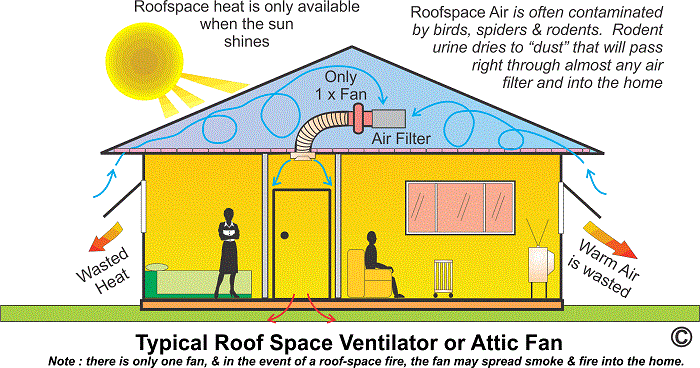VENTILATION SYSTEMS
1) Exhaust Fans and Open Windows

CONVENTIONAL VENTILATION – Wastes Heat
In winter, an exhaust fan wastes heat energy by exhausting warm air. The fan may cost cents to operate, but to replace the heat that is exhausted when the home is effectively ventilated, can add $60 to $100 to your monthly energy bill.
In a modern home for the exhaust fan to function properly, an opening for fresh replacement air to enter the home is required (a window or vent). Exhausted air is replaced by fresh, cold, outdoor air that has to be heated by your home heating system. Open windows or window vents are uncontrolled ventilation… too much, or not enough and wasteful.
Exhaust fans and open windows defeat the very purpose of an energy efficient home.
2) Attic (Roof Space) Supply Fan

3) Dehumidifiers

A domestic dehumidifier is a variation of a common refrigerator. A fan recirculates warm moist room air over chilled metal plates inside the dehumidifier. Humidity condenses on the plates, in exactly the same way that humidity condenses on the outside of a drink can or glass. Condensation dribbles from the chilled plates into a bucket and you feel good when you empty the full bucket of water. Here’s what you may not know….
A dehumidifier removes moisture by recirculating room air. If the air is stale, odorous and polluted, the dehumidifier will remove the moisture, but nothing else. In fact if the room is occupied while the dehumidifier is in operation, indoor contaminants increase. Recirculating foul air “stirs up” pollutants such as dust mite allergens.
Claims that dehumidifiers control dust mites in normal home use are incorrect. In an average New Zealand home one dehumidifier makes little difference to dust mite populations. NZ Standard 4303 “Ventilation for Acceptable Indoor Air Quality” recommends whole home ventilation (with fresh outdoor air) at the rate of one air change every 3 hours. A recirculating air dehumidifier does nothing to ventilation needs. Many dehumidifiers are noisy, and scientific tests have identified that unless appropriately disinfected, the inaccessible cooling plates, water buckets and surrounds of dehumidifiers support and encourage the growth of harmful moulds, fungi and bacteria. Click here to visit the web site of an independent building inspector and see what he has to say on the subject of dehumidifiers.
4) Heat Recovery Ventilator (HRV)

HEAT RECOVERY VENTILATOR (H.R.V.)
Ventilates, Reduces Relative Humidity & Recycles Waste Heat
(with doors & windows securely shut)
The HRV illustrated above is shown installed in the roofspace, (sourcing OUTDOOR AIR). CLEANAIRE has a range of models to suit most homes.
CLEANAIRE HRVs are designed to ventilate homes with 100% fresh outdoor air, at the rate recommended in NZ Standard 4303 “Ventilation for Acceptable Indoor Air Quality” ie one air change every 3 hours. Each model has two ultra-quiet fans, one to exhaust stale humid air and another supply fan to replace exhausted air with dry warm outdoor air. Heat from the exhaust air stream is “captured” by a heat exchanger and recycled to preheat the incoming cold, fresh outdoor air. The relative humidity of the outdoor air is reduced when the air stream is warmed by the heat exchanger. Introducing fresh, warm, dry air into your home evaporates and controls condensation (similar to a motor car windscreen warm air demister, or hair or clothes dryers).
Polluted, damp indoor air is continuously exhausted and replaced by 100% fresh outdoor air. Excess humidity is positively exhausted to outside with the foul air and, in some conditions condenses on the heat exchanger plates (exhaust side only) to be disposed of by the HRV drain.
Continuous trickle ventilation with fresh, warm outdoor air dilutes indoor air contaminants, which are positively removed by the exhaust fan. The result is an indoor environment that is always fresh and healthy.
The CLEANAIRE HRV performs best when winter conditions are at their worst, day and night. In an average (heated) home, additional heat (or sunshine) is unnecessary.
Genuine HRV’s continuously…
Reduce humidity and remove condensation.
- Exhaust stale humid polluted air
- Replace stale air, with fresh, dry, warm outdoor air.
- Transfer waste exhaust heat, to incoming fresh air.
- Transfer heat (i.e. from lounge log burner) around the home.
- Save up to 5 times more energy than it costs to run.
- Reduce greenhouse gas emissions, by recycling energy.
CONTACT US.

Email: info@avonelectric.co.nz
Products are New Zealand made by Avon Electric Ltd.
Ph: 03 381-5595 - Fax: 03 381-5596